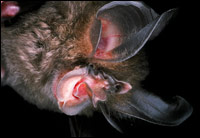In a move likened to “a microbiological episode of CSI,” a team of scientists has uncovered the culprit behind a disease that shook the world — and that could very well strike again. Researchers announced today that they’ve traced the global SARS epidemic, which spread to 26 countries and infected thousands of people, to one small creature: the horseshoe bat.

Small bat, big problem.
Photo: Tigga Kingston.
“This is a huge question everyone wanted the answer to,” says Mary Pearl, president of Wildlife Trust. The Trust cofounded and houses the Consortium for Conservation Medicine, whose researchers helped seal the deal. Jonathan Epstein, senior research scientist at CCM, led a team of 16 Chinese and Australian scientists that collected and analyzed samples from across mainland China last year. After testing cultures and blood from more than 400 bats in five separate labs, they confirmed the presence of a SARS-like virus in three species. They will publish their findings in an upcoming issue of Science.
“We can now conclusively say that we know the origin of SARS, and … the virus was transmitted from animals to people,” said Peter Daszak, executive director of CCM and a coauthor of the article. He says animal-to-human transmission is increasingly the case with emerging diseases — including monkeypox, West Nile virus, and avian flu — in a world greatly changed by ramped-up travel, trade, and development.
The highly contagious SARS (severe acute respiratory syndrome) appeared in southern China in late 2002. During the next year, the disease — and fears of contracting it — gripped the globe. Images of mask-clad citizens peppered the nightly news, and authorities closed schools, enacted quarantines, and issued travel advisories. As one victim after another succumbed to a sometimes-fatal combination of cough, high fever, and respiratory distress, the World Health Organization struggled to understand the origins and transmission of this “atypical pneumonia.” The outbreak, now estimated to have cost $50 billion, was largely contained by the summer of 2003, although sporadic cases have been suspected since.
Researchers discovered that SARS was caused by a type of virus called a coronavirus. Because the outbreak was traced to markets where live animals were sold, authorities eventually pinned the disease on the civet, a small, ferret-like mammal considered a delicacy. But traces of the virus were also found in several other animal species, including bats, leaving many questions unanswered. So Epstein — a veterinarian with a degree in public health who’s also something of a bat specialist — headed to China’s caves and marketplaces in search of the truth.
The bat that carried the virus is often sold as food, Epstein explains, and its feces are sometimes used medicinally — even, coincidentally, as a treatment for respiratory problems. The unlucky civets, he adds, were probably infected by the bats as well; civets in the wild did not carry the virus. In short, he says, “this would have remained a bat coronavirus if not for human intervention.”
Understanding the true source of the disease, researchers say, provides a way to predict and prevent future outbreaks. While SARS may seem like old news to some, that’s not the case. “Lethal viruses tend to flare up and disappear,” Pearl says. “The fact that the outbreak is over does not mean we can pretend it’s not a problem, or that it’s not coming back. But by identifying the link between SARS and the human population, we can take steps to break that link.” These steps might include educating people about the risks of eating the bats, or encouraging markets not to sell them.
For Daszak and his colleagues, the finding emphasizes the vital relationship between humans, the environment, and public health — a nexus that is the focus of CCM’s work. The growing field of conservation medicine, which entails collaboration between experts from different fields, is increasingly relevant on a planet with a booming human population. The makeup of the research team, which included veterinarians, zoologists, virologists, and epidemiologists, shows that such collaborations are effective, Epstein says: “This was a real team effort, and the sum of people’s knowledge is what made [the discovery] possible.” Staff members from CCM are currently working with scientists and public-health officials in several countries, including China, to create conservation-medicine programs similar to their own.
Pearl hopes today’s news will help raise awareness of the fact that diseases like SARS don’t come from nowhere. “Emerging diseases are often reported as scary acts of God, much as hurricanes are, and links to human activities are not fully covered,” she says. “People are beginning to understand [the connections]. The question is, what do we do now?”
Adds Epstein, “These diseases emerge because of human activities. If we just protected ecosystems, we’d protect both animal and human health. It’s a preventable thing — that’s the bottom line.”


